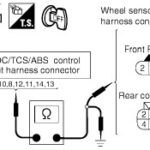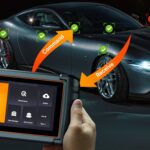For owners of the 2006 Ford F-150, upgrading the factory radio to an aftermarket unit is a popular modification. However, sometimes this seemingly simple upgrade can lead to unexpected issues, and one common concern that arises is whether installing an aftermarket radio can affect the OBD2 port, potentially causing it to stop working. If you’re experiencing problems with your OBD2 port after a radio install, you’re in the right place. This guide will explore the potential links between an aftermarket radio and a non-functional OBD2 port in your 2006 F-150, and provide you with troubleshooting steps and solutions.
It’s a frustrating situation: you install a new radio to enjoy enhanced audio and features, only to find that you can no longer use your OBD2 scanner to check engine codes or monitor vehicle data. While it might seem like the new radio is directly interfering with the diagnostic port, the reality is usually a bit more nuanced. Let’s break down the possible connections and how to diagnose the real problem.
Understanding the Electrical Systems: Radio and OBD2 Port
First, it’s important to understand that the factory radio and the OBD2 port are generally on separate electrical circuits within your Ford F-150. The OBD2 port is primarily connected to the vehicle’s computer (PCM/ECU) and the diagnostic system. Its main function is to provide access to vehicle data for emissions testing, diagnostics, and performance monitoring. The radio, on the other hand, is part of the entertainment system, drawing power and often connected to the vehicle’s speakers and antenna.
Direct electrical interference between a properly installed aftermarket radio and the OBD2 port is unlikely. They are designed as independent systems. However, the process of installing an aftermarket radio can inadvertently lead to issues that appear to affect the OBD2 port.
Why an Aftermarket Radio Installation Might Seem to Affect the OBD2 Port
So, if direct interference is unlikely, why do some 2006 F-150 owners find their OBD2 port not working after installing a new radio? Here are the most common scenarios:
1. Coincidental Timing: Sometimes, the OBD2 port issue is simply coincidental. The port might have been on the verge of failing or had a pre-existing problem that surfaces around the same time as the radio installation. Correlation doesn’t equal causation.
2. Wiring Errors During Installation: This is the most probable cause. When installing an aftermarket radio, you’re working with the vehicle’s wiring. Mistakes during this process can lead to various electrical problems, some of which can indirectly affect the OBD2 port circuit. Common wiring errors include:
- Accidentally Disconnecting or Damaging Wires: In the tight space behind the dashboard, it’s possible to accidentally disconnect or damage wires related to the OBD2 system while working on the radio wiring.
- Incorrect Wiring of the Radio: If the aftermarket radio is wired incorrectly, it could potentially cause a short circuit or power surge that affects other vehicle systems, including the diagnostic system circuit. This is less likely to directly damage the OBD2 port itself, but could disable the systems it relies on.
- Fuse Issues: During installation, a fuse related to the OBD2 port or the vehicle’s computer might be blown due to a wiring mistake or accidental short circuit. Fuses are designed to protect circuits, and a blown fuse is often the first sign of an electrical problem.
3. Power Drain or Electrical Overload: In rare cases, an improperly installed or incompatible aftermarket radio could create an excessive power draw or electrical overload on the vehicle’s electrical system. While less likely to directly kill the OBD2 port, a significant electrical issue could disrupt various systems, potentially including the diagnostic system.
4. Grounding Problems: Poor grounding of the aftermarket radio can sometimes lead to electrical noise or interference within the vehicle’s electrical system. While this is less likely to directly affect the OBD2 data communication, it’s a general electrical issue to be aware of during installation.
Troubleshooting Steps: Diagnosing the OBD2 Port Issue After Radio Install
If your OBD2 port isn’t working after installing an aftermarket radio in your 2006 F-150, follow these troubleshooting steps to pinpoint the cause:
Step 1: Check the Fuses
This is always the first and easiest step in diagnosing electrical problems. Locate the fuse box in your F-150 (usually under the dashboard or in the engine compartment – consult your owner’s manual for the exact location). Check the fuses related to:
- OBD2 Port/Data Link Connector (DLC): Refer to your owner’s manual for the specific fuse number associated with the OBD2 port or Data Link Connector.
- PCM/ECU (Powertrain Control Module/Engine Control Unit): The OBD2 port relies on the vehicle’s computer to function. Check the fuses for the PCM/ECU.
- Radio/Accessories: While less directly related, check the fuses for the radio and accessory circuits as well, in case of a broader electrical issue.
Inspect each fuse visually. A blown fuse will typically have a broken filament inside. Replace any blown fuses with fuses of the exact same amperage rating. After replacing fuses, try your OBD2 scanner again.
Step 2: Carefully Inspect the Radio Wiring
This is crucial, especially if the fuses are intact. You’ll need to access the wiring behind your radio. Carefully examine the following:
- Wiring Harness Connections: Ensure that all connections between the aftermarket radio harness and the vehicle’s wiring harness are secure and properly mated. Are any pins bent or pushed out? Are any connectors loose?
- Wire Damage: Look for any signs of damaged wires – cuts, crimps, or exposed bare wire. Pay close attention to areas where you were working during the radio installation.
- Incorrect Wiring: Double-check that you’ve followed the wiring diagrams for both your aftermarket radio and your 2006 F-150. Are all wires connected to the correct corresponding wires? Using the wrong wiring adapter or making incorrect connections can cause problems.
- Loose Wires: Are there any loose wires that could be shorting against metal parts of the dashboard?
If you find any wiring issues, carefully correct them. If you’re not comfortable working with electrical wiring, it’s best to seek help from a professional car audio installer or mechanic.
Step 3: Test the OBD2 Port with a Scanner
Try using your OBD2 scanner again after checking the fuses and wiring.
- Try a Different Scanner: If your scanner still doesn’t work, try using a different OBD2 scanner if possible. It’s less likely, but your scanner itself could be faulty.
- Check for Power at the OBD2 Port: A multimeter can be used to check for power at the OBD2 port. Pin 16 of the OBD2 port should have battery voltage (12V+). Pin 4 or 5 should be ground. If there’s no power, it indicates a problem with the power supply to the port.
Step 4: Disconnect the Aftermarket Radio (Temporarily)
As a diagnostic step, temporarily disconnect the aftermarket radio completely. This will eliminate the radio installation as a potential factor. After disconnecting the radio, try using your OBD2 scanner again.
- If the OBD2 port starts working after disconnecting the radio: This strongly suggests that the radio installation is indeed the source of the problem. Re-examine your wiring and installation carefully. There might be a wiring error, a short circuit, or an issue with the radio itself.
- If the OBD2 port still doesn’t work after disconnecting the radio: The problem is likely unrelated to the aftermarket radio installation. The OBD2 port issue might be coincidental, or there could be a separate electrical or computer problem within your F-150. In this case, further diagnosis by a professional mechanic is recommended.
Step 5: Check the Radio Ground
Ensure that the aftermarket radio is properly grounded. A poor ground can sometimes cause electrical issues. The radio’s ground wire should be securely connected to a clean, bare metal part of the vehicle’s chassis.
Preventing OBD2 Port Issues During Aftermarket Radio Installation
To minimize the risk of encountering OBD2 port problems (or other electrical issues) when installing an aftermarket radio in your 2006 F-150, follow these preventative measures:
- Use a Wiring Harness Adapter: Always use a proper wiring harness adapter designed for your 2006 Ford F-150. This adapter plugs into the factory radio harness and provides standardized connections for your aftermarket radio, minimizing the need to cut or splice factory wires.
- Follow Wiring Diagrams Carefully: Consult the wiring diagrams for both your aftermarket radio and your 2006 F-150. Double-check all wire connections before making them.
- Take Your Time and Be Gentle: Work carefully and avoid rushing the installation process. Be gentle when handling wires and connectors to prevent damage.
- Test Before Final Assembly: Before fully reassembling the dashboard, test the radio and your vehicle’s other electrical functions (including the OBD2 port, if possible) to ensure everything is working correctly.
- Consider Professional Installation: If you are not comfortable with car audio wiring or electrical work, consider having your aftermarket radio professionally installed by a qualified car audio shop.
Conclusion
While a properly installed aftermarket radio is unlikely to directly cause your 2006 Ford F-150’s OBD2 port to stop working, mistakes during the installation process can definitely lead to electrical issues that can affect the diagnostic system. By following these troubleshooting steps and preventative measures, you can effectively diagnose and resolve OBD2 port problems that arise after a radio install. Remember to prioritize safety when working with your vehicle’s electrical system, and don’t hesitate to seek professional help if you’re unsure or uncomfortable at any point.

